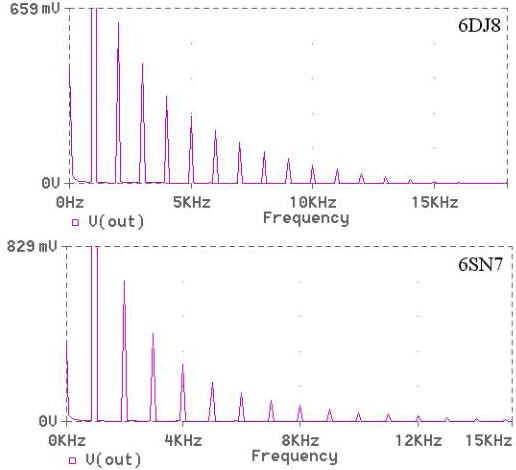|
|
|
|
"Looped" Amplifiers

Fig. 1
From
the Block Diagram in Fig. 1 you have:
By
solving with respect to ein you
obtains:

(3)
where:
g=
1+b*G1, a=
(4*b*G2)/g^2
(4)
The square
root can be appoximated with the following expression:

(5)
Backward
substitutions show a very interesting result: although A
yields only 2nd order
effects, the Feed-Back amplifier reducing the THD extends drammatically the
harmonic spectrum. This artful behaviour of amplifiers with NFB could be
correlatated with timbric
alteration that some people seem to notice during the listening with
“looped” amplifiers in critical situations.
The
Cathode Follower

Fig. 2
Thanks to relatively low
output inpedance approximatively equal to 1/gm and good current capabilities,
designers use this circuit for impedance matching, as driver and ,more rarely,
as output stage (also in the OTL configurations).
By assuming:
ik=
h1*eg + h2*eg^2
since:
vout=
ZL*ik
 (6)
(6)
where:
a=
(4*ZL*h2)/(ZL*h1+1).

Fig. 3
Therefore, also
under the qualitative profile a cathode follower presents a non-linear behaviour
very close to that of the block
diagram in Fig. 1.
Fig. 3 shows harmonic spectra about two different cathode followers when
the output signals have both 1% of
THD. You can observe a large harmonic
content counterbalancing a relatively low THD. Some designers are deeply
convinced about the harmfulness of this behaviour expecially in a sonic context,
therefore they refuse the use of Cathode Follower because they outline that, as
a stage having 100% of Negative FeedBack, sonic deterioration is superior to
electrical benefits. Others, also attributing this structure a potential sonic
degradation of the processed information, above all when signal swings are
elevated, admit the superiority of benefits with respect to disadvantages.
Really a good Cathode Follower can result essential for matching impedances and
driving capacitive loads. Further a low cost Class A2 driver it’s unthinkable
without a Cathode Follower. I believe that cathode followers don’t have the
dynamic compression sensation often recognizable in poor designed common cathode
amplifiers. Nevertheless signal peaks can be cut with modalities that you can
find both in solid state stages and full amplifiers with overall feedback.
A simple common cathode stage always saturate softly.